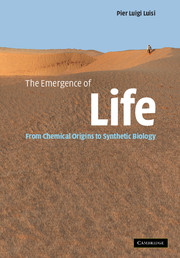Book contents
- Frontmatter
- Contents
- Preface
- Acknowledgments
- List of books on the origin of life
- 1 Conceptual framework of research on the origin of life on Earth
- 2 Approaches to the definitions of life
- 3 Selection in prebiotic chemistry: why this … and not that?
- 4 The bottle neck: macromolecular sequences
- 5 Self-organization
- 6 The notion of emergence
- 7 Self-replication and self-reproduction
- 8 Autopoiesis: the logic of cellular life
- 9 Compartments
- 10 Reactivity and transformation of vesicles
- 11 Approaches to the minimal cell
- Outlook
- References
- Index
7 - Self-replication and self-reproduction
Published online by Cambridge University Press: 17 December 2010
- Frontmatter
- Contents
- Preface
- Acknowledgments
- List of books on the origin of life
- 1 Conceptual framework of research on the origin of life on Earth
- 2 Approaches to the definitions of life
- 3 Selection in prebiotic chemistry: why this … and not that?
- 4 The bottle neck: macromolecular sequences
- 5 Self-organization
- 6 The notion of emergence
- 7 Self-replication and self-reproduction
- 8 Autopoiesis: the logic of cellular life
- 9 Compartments
- 10 Reactivity and transformation of vesicles
- 11 Approaches to the minimal cell
- Outlook
- References
- Index
Summary
Introduction
Let's start with a semantic note about the two terms self-replication and self-reproduction. Although often treated synonymously, they are not equivalent. There has been a discrimination between the two in the literature for some time, the clearest proponent being Dyson (1985). In fact, self-replication (the word comes from the Latin replica) means a faithful molecular copy, while self-reproduction refers rather to a statistical process of making very similar things. Thus, cells self-reproduce, while molecules self-replicate. It is not simply a semantic question, as according to Dyson (Dyson, 1985), self-reproduction processes, being less precise, in the early evolution most likely preceded self-replication processes, which require more complex control and editing.
Self-reproduction is rightly seen as the main motor for the development of life on Earth. Life unfolds in time by repetition patterns: one family of dolphins gives rise to a new family of dolphins, one family of roses gives rise to a new family of roses. This is a subtle, invisible thread that links the present beings to all those that have existed before and to all those who will come. Looking back, everything condenses into the original cellular family, the whimsical LUCA (last universal common ancestor); this, by the way, should not be confused with the origin-of-life protocell, as this is a much older event.
Self-replication and non-linearity
There are some good reasons why, in the field of the origin of life, the emergence of self-reproduction is of such paramount importance.
- Type
- Chapter
- Information
- The Emergence of LifeFrom Chemical Origins to Synthetic Biology, pp. 129 - 154Publisher: Cambridge University PressPrint publication year: 2006
- 1
- Cited by



